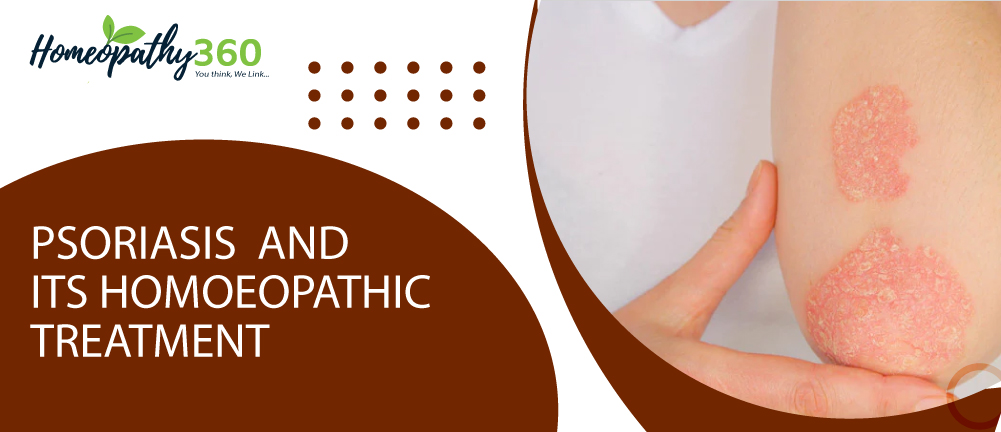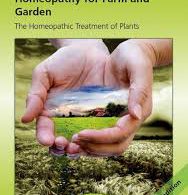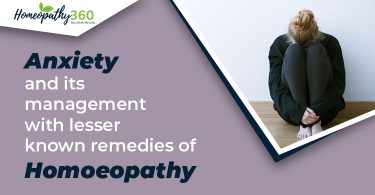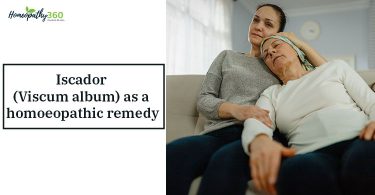
ABSTRACT-Psoriasis a chronic inflammatory condition , hyperproliferative skin disease. It is a type of autoimmune disease and characterized by well defined , erythematous scaly plaque particularly affecting extensor surfaces , scalp and nails , and usually follows a relapsing and remitting course. In such cases homoeopathic medicines are always beneficial when given after individualisation of the patient and prescribed medicine must be exact similimum in order to cure the patient.
KEY WORDS- Psoriasis , Homoeopathy.
Introduction
Psoriasis is a long-lasting, noncontagious1,autoimmune disease characterized by raised areas of abnormal skin.2 These areas are red, or purple on some people with darker skin,3 dry, itchy, and scaly. Psoriasis varies in severity from small, localized patches to complete body coverage.4 Injury to the skin can trigger psoriatic skin changes at that spot, which is known as the Koebner phenomenon.
Epidemiology
Although psoriasis occurs worldwide, its prevalence varies considerably. In the USA, approximately 2% of the population is affected.
Psoriasis can present at any age and has been reported at birth and in older people of advanced age. The mean age of onset for the first presentation of psoriasis can range from 15 to 20 years of age, with a second peak occurring at 55–60 years.5
CLINICAL FEATURES
Psoriasis is a papulosquamous illness with a wide range of appearance, severity, and course. Scaling papules (raised lesions less than 1 cm in diameter) and plaques (raised lesions greater than 1 cm in diameter) are the hallmarks of papulosquamous illnesses.. Furthermore, the lesions are usually symmetrically distributed on the scalp, elbows, knees, lumbosacral area, and body folds . The phenomenon of Koebner’s psoriasis occurs when psoriasis develops at the site of trauma or injury.
Psoriasis can sometimes affect the oral mucosa and tongue. When the tongue is affected, strongly delimited gyrate red spots with a white-yellow border may appear on the dorsal surface. The patches can change and spread on a daily basis, taking on various circular patterns and resembling a map, therefore the name geographic tongue.
The shape, location, and severity of psoriasis can all be quite different. Despite the above-mentioned characteristic presentation, the morphology can range from small tear-shaped papules (guttate psoriasis) to pustules (pustular psoriasis) and generalised erythema and scale (erythrodermic psoriasis). Furthermore, these various types of psoriasis might be localised or widespread, making them disabling. Psoriasis can also take a variety of forms, such as chronic, stable plaques or an acute flare-up with rapid advancement and broad involvement. Patients with psoriasis may experience acute itching or burning as a symptom.
CLINICAL TYPES OF PSORIASIS
Plaque psoriasis
The commonest form of psoriasis is plaque psoriasis in which patients may have sharply circumscribed, round-oval, or nummular (coin-sized) plaques . The lesions may initially begin as erythematous macules (flat and <1 cm) or papules, extend peripherally, and coalesce to form plaques of one to several centimetres in diameter. A white blanching ring, known as Woronoff’s ring, may be observed on the skin surrounding a psoriatic plaque. With gradual peripheral extension, plaques may develop different configurations including:
- psoriasis gyrata—in which curved linear patterns predominate
- annular psoriasis—in which ring-like lesions develop secondary to central clearing
- psoriasis follicularis—in which minute scaly papules are present at the openings of pilosebaceous follicles.
The terms rupioid and ostraceous relate to distinct morphological subtypes of plaque psoriasis. Rupioid plaques are small (2–5 cm in diameter) and highly hyperkeratotic, resembling limpet shells. Ostraceous psoriasis refers to hyperkeratotic plaques with relatively concave centres, similar in shape to oyster shells.
Scale is typically present in psoriasis, is characteristically silvery white, and can vary in thickness. Removal of scale may reveal tiny bleeding points (Auspitz sign). The amount of scaling varies among patients and even at different sites on a given patient. In acute inflammatory or exanthematic psoriasis, scaling can be minimal and erythema may be the predominant clinical sign.6
Guttate psoriasis
Guttate psoriasis, from the Greek word gutta meaning a droplet, describes the acute onset of a myriad of small, 2–10 mm diameter lesions of psoriasis. These are usually distributed in a centripetal fashion although guttate lesions can also involve the head and limbs. Guttate psoriasis accounts for 2% of the total cases of psoriasis.
Flexural (inverse) psoriasis
Psoriasis affecting the flexures, particularly inframammary, perineal, and axillary, is distinct morphologically from traditional plaques elsewhere on the trunk and limbs. Flexural lesions are devoid of scale and appear as red, shiny, well demarcated plaques occasionally confused with candidal, intertrigo, and dermatophyte infections.
Erythroderma
Total or subtotal involvement of the skin by active psoriasis is known as erythroderma and may take one of two forms. Firstly, chronic plaque psoriasis may gradually progress as plaques become confluent and extensive. Secondly, erythroderma may be a manifestation of unstable psoriasis precipitated by infection, tar, drugs, or withdrawal of corticosteroids.
Generalised pustular psoriasis
Generalised pustular psoriasis is rare and represents active, unstable disease. Precipitants include withdrawal of systemic or potent topical corticosteroids and infections. The patient is pyrexial, with red, painful, inflamed skin studded with monomorphic, sterile pustules, which may coalesce to form sheets. Patients with generalised pustular psoriasis frequently need to be admitted to the hospital for management.
Palmoplantar pustulosis
Palmoplantar pustulosis presents as sterile, yellow pustules on a background of erythema and scaling affecting the palms and/or soles. The pustules are tender and fade to form dark brown coloration with adherent scale/crust. Palmoplantar pustulosis is frequently associated with psoriatic nail involvement.7
Psoriatic nail disease
Fingernails are more commonly affected than toenails. The commonest finding is small pits in the nail plate, resulting from defective nail formation in the proximal portion of the nail matrix . The nail may also detach from the bed at its distal or lateral attachments, known as onycholysis.
Homoeopathic treatment of psoriasis 8–
- Petroleum-Psoriasis of hands. Thick , greenish crust , burning and itching ; redness, raw; crack bleeds easily. Ailments are worse during winter season. Worse, dampness, before and during thunderstorm ,in winter, eating ,from mental states. Better, warm air; dry weather.
- Magnum aceticum -suppuration of skin around joints. Red ,elevated spots. Itching better by scratching . Deep cracks in bends of elbow . Worse, cold wet weather .Better, lying down.
- Iris versicolor- Psoriasis irregular patches with shining scales Worse, in evening and at night , from rest .Better ,from continuous motion.
- Asterian rubens-Destitute of pliability and elasticity. Itching spots. Psoriasis and herpes zoster worse left arm and chest.Psoriasis worse ,at night and damp weather.
- Hydrocotyle asiatica-Dry eruptions. Great thickening of epidermoid layer and exfoliation of scales . Psoriasis gyrate , on trunk and extremities , palms and soles. Circular spots , with scaly edges. Intolerable itching especially of soles. Profuse sweat worse .
- Arsenic iodatum-Dry ,scaly ,itching . Marked exfoliation of skin in large scales , leaving a raw exuding surface beneath. Icthyosis. Itching worse by washing .Psoriasis.
- Arsenic album-Itching ,Burning , Swelling ; odema, eruption, papular, dry , rough , scaly ; worse cold and scratching . Icy coldness of the body .
- Castor equi- Psoriasis linguae.
- Corallium rubrum-Coral colored, then dark red spots. Psoriasis of palms and soles worse in open air ,changing from a warm to cold room.
- Kalium arsenicosum- Intolerable itching , worse undressing . Dry scaly, wilted .Itching worse from warmth , walking , undressing . ali arsenicum patient tends towards malignancy and inveterate skin diseases. He is restless, nervous and anemic
References-
1.Boehncke WH, Schön MP (September 2015). “Psoriasis”. Lancet. 386 (9997): 983–94. doi:10.1016/S0140-6736(14)61909-7. PMID 26025581. S2CID 208793879.(CITED ON-21-05-2022)
2.”Questions and Answers About Psoriasis“. National Institute of Arthritis and Musculoskeletal and Skin Diseases. 12 April 2017. Archived from the original on 22 April 2017. Retrieved 22 April 2017.(CITED ON-22-05-2022)
3. LeMone P, Burke K, Dwyer T, Levett-Jones T, Moxham L, Reid-Searl K (2015). Medical–Surgical Nursing. Pearson Higher Education AU. p. 454. ISBN 9781486014408.(CITED ON -22-05-2022)
4. Menter A, Gottlieb A, Feldman SR, Van Voorhees AS, Leonardi CL, Gordon KB, et al. (May 2008). “Guidelines of care for the management of psoriasis and psoriatic arthritis: Section 1. Overview of psoriasis and guidelines of care for the treatment of psoriasis with biologics”. Journal of the American Academy of Dermatology. 58 (5): 826–50. doi:10.1016/j.jaad.2008.02.039. PMID 18423260.(CITED ON -23-05-2022)
5. Henseler T, Christophers E. Psoriasis of early and late onset: characterization of two types of psoriasis vulgaris. J Am Acad Dermatol1985;13:450–6.(CITED ON-26-05-2022)
6. . Correspondence to:Dr R G B Langley,Division of Dermatology, Department of Medicine, Dalhousie University, 4195 Dickson Building, 5820 University Avenue, Halifax, Nova Scotia, Canada B3H 1V6;(CITED ON-29-05-2022).
7. Asumalahti K, Ameen M, Suomela S, Hagforsen E, Michaelsson G, Evans J, et al. Genetic analysis of PSORS1 distinguishes guttate psoriasis and palmoplantar pustulosis. J Invest Dermatol2003;120:627–32.(CITED ON-27-05-2022)
8.BoerickeW (2013).Boericke’s New Manual of homoeopathic materia medica with repertory.9th ed. New Delhi;B,Jain Publishers(P)LTD.(CITED ON -29-05-2022).
About Author:
Dr.Yasha soni, Dr. Charushila Sharma ,Dr. Ankita Srivastava, Dr.Somendra Yadav, Dr.Itika khatri.
M.D (PGR)Department of materia medica. Dr. MPK homoeopathic medical college and research center ,Jaipur, Rajasthan, India.





